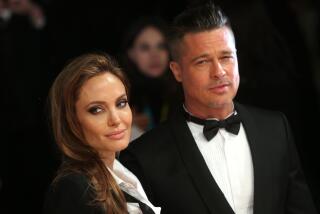Angelina Jolie’s double mastectomy right for some women, doctors say

- Share via
Angelina Jolie’s decision to undergo a preventative double mastectomy to reduce breast cancer risk was a natural move given that she carried a dangerously faulty gene, cancer surgeons said, but it’s a decision that really befits only a select group of women.
Only about 5% of breast cancer patients carry a dangerous mutation in their BRCA1 or BRCA2 genes, said Dr. Julian Kim, chief of surgical oncology at the University Hospitals Case Medical Center and chief medical officer of the UH Seidman Cancer Center in Cleveland.
“Now this is a very, very small segment of the population that has this mutation,” Kim said. “So this does not apply to the general public, normal risk, female patient.”
For those women, getting a double mastectomy is quite common, he said. That’s because, for those with the gene mutation, risk of developing breast cancer over a lifetime shoots up to about 85%. Ovarian cancer goes up about 50% as well, Kim said. For women with such high hereditary cancer risk, removing ovaries and breast tissue can bring risk of breast and ovarian cancer down by 90% to 95%.
This was similar reasoning used by Jolie, who in an op-ed unflinchingly describes three months of medical procedures after discovering she carried a mutated BRCA1 gene: The discomfort of “nipple delay,” a procedure to rule out disease in the breast ducts behind the nipple and raise chances of saving the nipple; removal and replacement of the breast tissue weeks later; and what it was like to awaken to drain tubes and expanders in both breasts.
“It does feel like a scene out of a science-fiction film,” Jolie wrote. “But days after surgery you can be back to a normal life.”
Preventative double mastectomies have become increasingly appealing in part because the reconstruction surgery has dramatically improved in the last 10 to 15 years, Kim said. Just 25 years ago, a woman would simply have the entire breast removed, and wear prostheses in her bra underneath clothing. Now, surgeons can save the nipple, and much of the breast skin, and then fill it with an implant.
“Many of these patients actually have an enhanced cosmetic result as compared to prior to surgery,” said Kim, who was one among the first surgeons in the U.S to perform nipple-saving procedures. “So you’re reducing your risk of breast cancer, but you’re not paying a penalty in terms of the cosmetic result.”
Ultimately, having, or not having, a preventative double mastectomy is a deeply personal choice, Kim said.
“I would hope no one would judge an individual person on their decision,” Kim said. “There’s a lot of factors that go into these types of decisions, other than the numbers.”
Follow me on Twitter @aminawrite.
[For the record, 3:03 p.m. May 14: An earlier version of this post said that the type of gene mutation Jolie has can be found in either the BRCA1 or BRCA2 genes, which is incorrect. Dangerous mutations, however, can occur in either gene.]







